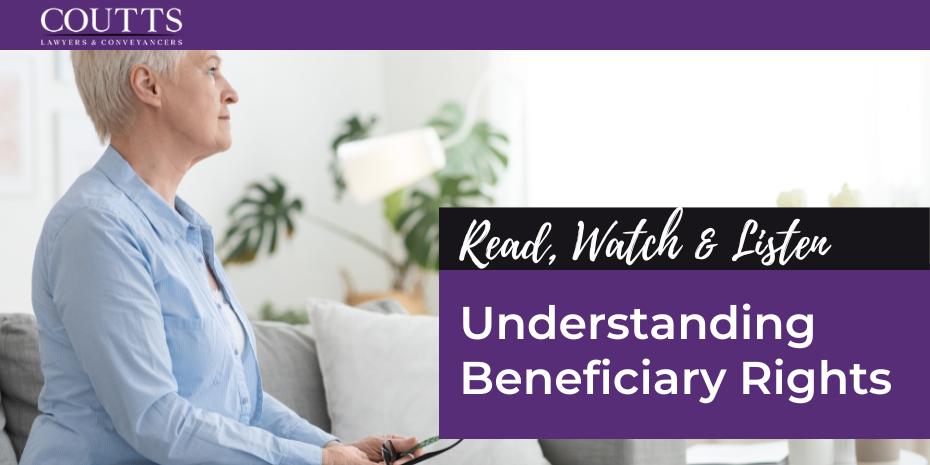KEY TAKE-OUTS
- Letters of Administration is the process where someone passes away without a Will and their loved ones take on the job to be appointed as Administrator of the Estate through the Supreme Court of
- An Administrator is a person who is appointed by the Supreme Court of NSW and is responsible for controlling and managing the Estate. The general duties include searching for an original Will, notifying all asset holders and creditors, filing an Application for a Grant of Letters of Administration, finalising all assets and paying the creditors, and lastly distributing the Estate in accordance with the rules of
- It is not always the case that a Grant of Letters of Administration for an Estate is required to be obtained, as it depends on the assets held by the
- The process for obtaining a Grant of Letters of Administration is very similar for every Estate, however, the length of time required for the entire duration of the process will depend on the size and nature of the
When someone passes away without a Will, the relatives of that person are required to take on the responsibility of Administrator of the Estate. An Administrator is appointed by the Supreme Court of NSW and they have the responsibility of controlling and managing the Estate.
It is important to note that not everyone is entitled to apply to be the Administrator of the Estate and the rules of intestacy govern who is able to be appointed as Administrator and who is entitled to receive the Estate.
Additionally, it is not always the case that an Administrator is required to obtain a formal Grant of Letters of Administration from the Supreme Court of NSW, as it is dependent upon the size and nature of the Estate. The biggest contributing factor to determine the need for a Grant of Letters of Administration is the consideration of the assets of the Estate and the requirements of the asset holders in order to close or transfer the assets. Assets of an Estate include things such as real estate, bank accounts, superannuation, shares held in a company and motor vehicles.
In the initial stages, the loved ones of a deceased person will generally engage a Deceased Estates Lawyer to assist them in navigating the rules of intestacy. The rules of intestacy are set by the Court and govern who is most appropriate to take on the role of Administrator and who is most entitled to benefit from the Estate.
However, some Estates do not require a Grant of Letters of Administration as not all asset holders require a Grant before finalising the accounts. Accordingly, if no asset holder of an Estate required a Grant of Letters of Administration, the most appropriate person who is to take on the role of Administrator will be able to finalise the assets and distribute the Estate in accordance with the laws of intestacy.
The process to obtain a Grant of Letters of Administration is similar amongst most Estates, however, the length of time for the process and the types of people who are eligible will differ depending upon the size and nature of the Estate. As a general overview, the process for obtaining a Grant of Letters of Administration is as follows:
-
Search for an original Will.
- This is the most important step in the entire process as we need to ensure that Letters of Administration is the right path to take for the Estate.
- At this stage in the matter, you should advise the Estate’s Lawyer of any law firm the Deceased person had contact with throughout their lifetime.
- As a general rule, steps should be taken to contact:
- The banking institutions that the Deceased person had dealings with;
- The Supreme Court of NSW;
- The NSW Trustee and Guardian; and
- A minimum of ten (10) law firms local to the area in which the Deceased person lived including any law firms that the Deceased person dealt with in their lifetime.
- If through your searches you locate a Will, then your process will change to apply for a Grant of Probate.
- However, if no Will is found through your searches, then these searches can be used as evidence in your Application for a Grant of Letters of Administration to prove there is no Will.
-
If no Will, ascertain who is eligible.
- Now that we know that there is no Will for the Deceased person, we then need to determine who is eligible to be appointed as the Administrator of the Estate and who is most entitled to benefit from the Estate.
Administrator
- As mentioned above, the Administrator is the person who is responsible for controlling and managing the Estate, through actions such as liaising with asset holders and creditors, preparing and filing an Application to the Court and distributing the Estate.
- Through the laws of intestacy, there is a hierarchy of people that are able to be appointed as the Administrator. The appointment starts from the top and if that person is unwilling or unable because they have passed away before the Deceased person, then it moves to the next tier in the hierarchy.
- The hierarchy is as follows:
1. Married or De Facto Spouse → 2. Children → 3. Grandchildren ↓
6. Nephews and Nieces ← 5. Siblings ← 4. Parents ↓
7. Grandparents → 8. Uncle & Aunt → 9. First Cousins - Once you determine who is the most eligible, based on the above, then they can proceed with the Application for a Grant of Letters of Administration.
Beneficiary
- Once the Administrator has been ascertained, we need to consider who the most eligible Beneficiary is.
- A Beneficiary is a person who receives the Estate, whether it be the cash assets or tangible assets.
- The same hierarchy applies to determine who is the most eligible Beneficiary.
- However, it is important to disclose the full family tree to the Estates Lawyer as children from a former relationship, may be entitled to a share of the Estate. This will mean that your current spouse will be entitled to your personal effects, a statutory legacy governed by the Legislation and 50% share of the rest of the Estate, whilst the children from the former relationship will be entitled to the other 50% of the rest of the Estate.
-
Notify all asset holders and creditors regarding the passing of the Deceased person.
- Next, you will need to prepare a list of all assets and liabilities in the name of the Deceased person.
- Once a list has been generated, it is important to make contact with each of them to notify of the passing of the Deceased person.
- This step is important because it is a way to determine the value of the Estate in order to accurately account for them in the Application.
- If you are unaware of the assets of the Estate, it is best practice to write to the major banks, the Australian Taxation Office and conduct an asset search through InfoTrack to investigate the possible assets owned.
- If you are unaware of the liabilities of the Estate, it is suggested that a Notice of Intended Distribution of Estate is filed once the Grant of Letters of Administration has been obtained by the Court. This is because it will put the creditors on notice to contact the Estates Lawyer and make a claim.
- In this instance, it is appropriate to advise the Estate’s Lawyer of the entire overview of the assets and liabilities of the Estate. once you have disclosed these assets and liabilities, it will be the Lawyers job to contact all asset holders to ascertain whether the asset holders need a Grant of Letters of Administration in order to release the funds, close the accounts or transfer the asset to a nominated beneficiary.
-
Prepare the Application for a Grant of Letters of Administration.
- Once you have received a response from all asset holders and creditors, you are now ready to complete the Application for a Grant of Letters of Administration.
- The Application should be filed with the Supreme Court of NSW no later than six (6) months from the date of death.
- As the final step, you will need to post the original Application for a Grant of Letters of Administration to the Supreme Court of NSW for filing.
- The turnaround time for the Court to review and file the Grant of Letters of Administration will depend on the Court’s capacity and generally, it is between 3-5 weeks for a standard Grant to be obtained.
-
Finalise the assets.
- Once you have the original Grant of Letters of Administration returned from the Court, the Administrator is now authorised to finalise the assets and pay the liabilities of the Estate.
- Finalising the assets can be conducted in many ways which include closing accounts and transferring the funds into an Estate bank account, transferring the assets to a beneficiary or selling the assets.
-
Distribute the Estate.
- Once you have finalised the assets, you are ready to distribute the Estate.
- Distribution means you transfer tangible assets or transfer the monetary funds to the beneficiaries entitled under the rules of intestacy.
- The distribution of the Estate should happen within 12 months from the date of death.
- The Administrator may decide to publish a Notice of Intended Distribution of an Estate, which puts notice to all creditors that the Estate will be distributed in thirty (30) days.
- Distribution of an Estate means that the creditors are to be paid from the Estate funds and all assets are divided, whether they are cash assets or tangible assets.
As mentioned, there is a general process for someone obtaining a Grant of Letters of Administration. The process is a little lengthier and more complex than the Probate process, however, the rules of intestacy vide a clear pathway to this type of Grant. It is beneficial that you engage a Deceased Estates Lawyer to help navigate through the rules of intestacy as they will endeavour to make the process more efficient and with no added stress to the family.
For further information please don’t hesitate to contact:
This blog is merely general and non-specific information on the subject matter and is not and should not be considered or relied on as legal advice. Coutts is not responsible for any cost, expense, loss or liability whatsoever to this blog, including all or any reliance on this blog or use or application of this blog by you.



